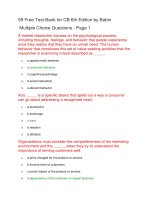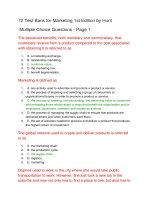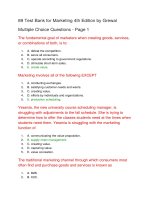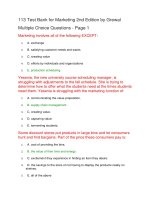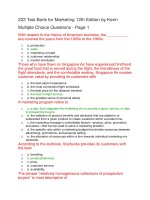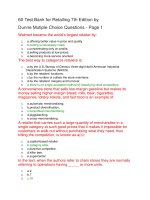Test bank for pathophysiology 4th edition by copstead kirkhorn
Bạn đang xem bản rút gọn của tài liệu. Xem và tải ngay bản đầy đủ của tài liệu tại đây (44.6 KB, 4 trang )
buy this full document at
Copstead-Kirkhorn: Pathophysiology, 4th Edition
Chapter 1: Introduction to Pathophysiology
Test Bank
TRUE/FALSE
1. Normal ranges for physiologic parameters are arbitrarily defined based on population
sampling.
ANS: T
2. Values outside the normal range for a particular variable are always indicative of disease.
ANS: F
3. Illness and disease always coexist.
ANS: F
4. Normalcy is culturally defined.
ANS: T
5. A change in a physiologic variable is more significant than the absolute values.
ANS: T
6. Most homeostatic mechanisms function via positive feedback loops.
ANS: F
7. Homeostatic control mechanisms function primarily during disease states.
ANS: F
8. Epidemiology is the study of disease expression in individuals.
ANS: F
9. The etiology and pathogenesis of most disease states have been well defined by research.
ANS: F
buy this full document at
Full file at />10. Individuals experiencing the same disease process exhibit the same clinical
manifestations.
ANS: F
MULTIPLE CHOICE
1. C.Q. was recently exposed to group A hemolytic Streptococcus and subsequently
developed a pharyngeal infection. His clinic examination reveals an oral temperature of
102.3° F, skin rash, and reddened throat mucosa with multiple pustules. He complains of
sore throat, malaise, and joint stiffness. A throat culture is positive for Streptococcus, and
antibiotics have been prescribed. The etiology of C.Q.’s disease is
a. a sore throat.
b. streptococcal infection.
c. genetic susceptibility.
d. pharyngitis.
ANS: B
2. Which of the following is a statement about disease pathogenesis?
a. Pharyngitis is caused by group A hemolytic Streptococcus infection.
b. Streptococcal infection activates immune cells, leading to inflammation.
c. Sore throat and mucosal inflammation are common signs and symptoms of
pharyngeal infection.
d. Antibiotics are the treatment of choice for streptococcal infection.
ANS: B
3. Which of the following assessment findings indicates an alteration in homeostatic control
mechanisms?
a. Fever
b. Throat pain
c. Joint stiffness
d. Positive throat culture
ANS: A
4. Most homeostatic mechanisms function on a negative-feedback principle, which
facilitates
a. minimal response to environmental changes.
b. an amplified response.
c. a rapid response rate.
d. steady-state stability.
ANS: D
5. A 17-year-old college-bound student receives a vaccine against an organism that causes
meningitis. This is an example of
Elsevier items and derived items © 2010, 2005 by Saunders, an imprint of Elsevier Inc.
Full file at />a.
b.
c.
d.
primary prevention.
secondary prevention.
tertiary prevention.
disease treatment.
ANS: A
6. An obese but otherwise healthy teen is given a prescription for a low-calorie diet and
exercise program. This is an example of
a. primary prevention.
b. secondary prevention.
c. tertiary prevention.
d. disease treatment.
ANS: B
7. A patient with high blood pressure who is otherwise healthy is counseled to restrict
sodium intake. This is an example of
a. primary prevention.
b. secondary prevention.
c. tertiary prevention.
d. disease treatment.
ANS: B
8. After suffering a heart attack, a middle-aged man is counseled to take a cholesterollowering medication. This is an example of
a. primary prevention.
b. secondary prevention.
c. tertiary prevention.
d. disease treatment.
ANS: C
MATCHING
Match the following terms with the descriptions below (not all letters will be used).
a. Idiopathic
b. Iatrogenic
c. Morbidity
d. Syndrome
e. Sequela
f. Remission
g. Complication
h. Exacerbation
i. Subclinical
j. Endemic
k. Pandemic
Elsevier items and derived items © 2010, 2005 by Saunders, an imprint of Elsevier Inc.
Full file at />l. Etiology
m. Epidemic
n. Epidemiology
1.
2.
3.
4.
5.
6.
7.
8.
9.
10.
11.
12.
The conditions or illnesses associated with a disease
A set of symptoms that occur together
A disorder of unknown cause
An abatement or decline in disease manifestations
A disease that is continuously present in a particular region
An epidemic that distributes to a large geographic area
An adverse condition occurring as a result of medical intervention
Common problems following a disease process
The known cause of a disease process
A new disease process arising secondarily to another disease
An absence of clinical manifestations despite the presence of a disease
An increase in the severity of disease signs and symptoms
1.
2.
3.
4.
5.
6.
7.
8.
9.
10.
11.
12.
ANS:
ANS:
ANS:
ANS:
ANS:
ANS:
ANS:
ANS:
ANS:
ANS:
ANS:
ANS:
C
D
A
F
J
K
B
E
L
G
I
H
Elsevier items and derived items © 2010, 2005 by Saunders, an imprint of Elsevier Inc.
